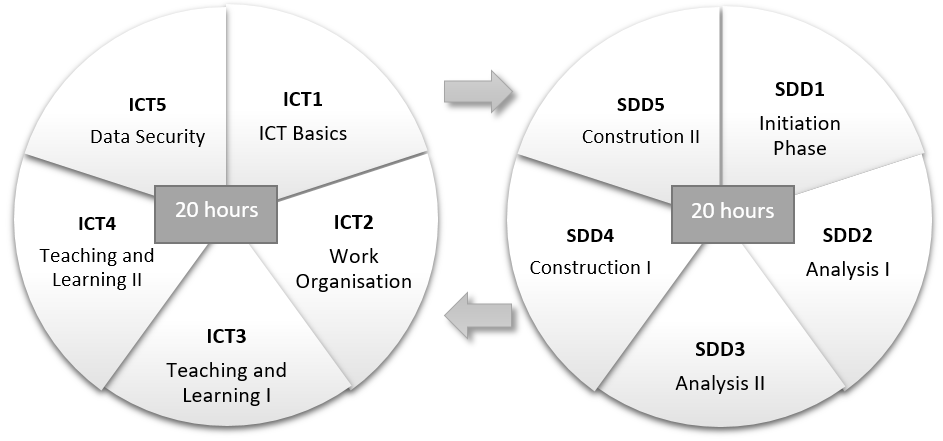Following our principles, we realised a course concept with these characteristics:
- This training course addresses multipliers. Multipliers can be engaged teachers, but also externals, who want to support school actors.
- Self-organised learning processes. Modules regarding digitisation and strategy development are structured in a way that allows a systematic elaboration of all learning and development goals. The manual (print and online) guides you through the complex procedure.
- Hints and tricks support the teaching style of the multiplier. Experts from digital media teaching and adult education developed and tested the course. The captured teaching experiences enrich the course manuals and give an orientation for the multiplier.
- Easy time structure. Each module consists of a number of units. Learn each unit (not conduct!) in round about 30 minutes. The conduction of the single work sessions takes between 2 and 3 hours.
- Online and free access to the materials. The teaching and learning materials we developed are freely available to everybody. Additional, a web community and there online discussions can support single multipliers and establish a growing network of strategy development experts
- The training structure combines useful information about digital media and strategy development knowledge and practice. This allows thinking in new ideas and identify possibilities to enhance the school from a holistic view.
- Use of various, animating methods. The course provides information and knowledge and therefore use presentations, step-by-step-directions, manuals and examples. To target competence development, we involved interactive and creative team sessions. Analogue technics, like the use of moderation walls, help to focus concentration on the content. Thanks to a recommended conduction range of the course, the learners are able to transfer new ICT skills to strategy development processes.
- Use our materials to learn and teach digitisation strategy development! We developed many learning and teaching media that you might use in our own courses. However, feel free to develop your own. To work actively with digital media enhances your own competence within this work field.
The STRIDE Guide approach is competence-based. It offers the possibility to acquire knowledge, gain experience and achieve results by discursive reflections with peers. There is no general strategic solutions are given, as the authors believe that this would not lead to the expected learning outcomes. We provide guidelines and examples, which cannot be right or wrong – only suitable or not.
Our Commision:
Bringing schools to modern age by enabling teachers to acquire digital skills, to use them in a creative and responsible manner and on this way do their part to create a modern teaching and learning culture.
Key Objectives:
Improvement of the addressees’ media competence as well as their ability to develop and plan school-specific strategies to forward teaching and learning in their specific context.
Learning Goals:
- To be able to use a selected number of digital tools for educational contexts.
- To know about actual information regarding data security.
- To be able to justify the implementation of a digital tool in class and to use it in a reflective manner.
- To know necessary steps of strategy development.
- To be able to develop a strategy plan following the provided material.
- To be able to transfer the acquired digital skills to the school-specific digitisation strategy.
Environment:
- Find our course on Training Path and work online.
- Learn self-organised, practice on your own and in your own speed.
- Meet your colleagues and finalise your work together with your team.
- Ask the community for support on Community.
- Study examples on Strategy Database.
Media:
Digital accessible material, software (freeware), learning videos and audio files
Methods:
Practice tasks, discussions, presentations and examples. Self-assessment.


